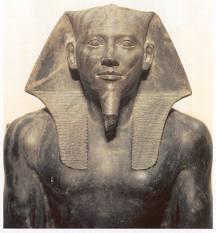*Pharaohs*
The pharaoh was the high priest of all temples, the head of law and administration, and the commander of the army. The Egyptians believed pharaohs were great people that were half-man and half-god. Since only the pharaoh and priests were allowed to enter temples, Ancient Egyptians had to ask the pharaoh to speak to the gods for them. This made the pharaoh very powerful in the minds of regular Egyptians! The Ancient Egyptians believed that the pharaoh's spirit could live for an eternity, which means forever. They believed that the pharaoh would become a god after he died, so pharaohs were buried in a tomb with many treasures which could be enjoyed in their Afterlife. Many of the statues of pharaohs have cobra heads on them. Pharaohs wore a cobra figure to protect them from evil.
**Hatshepsut
![]()
Hatshepsut was the first wife and queen of Thutmose II. They ruled Egypt until from 1518 BC until Thutmose II died in 1504 BC.
When Thutmose II died, Hatshepsut proclaimed herself Pharaoh, making her the first woman to rule Ancient Egypt. She remained in power until 1484 BC.
During the time of Hatshepsut's reign, the Egyptian economy flourished, and she expanded trading relations. She built many magnificent temples and other buildings.
**Cleopatra VII:
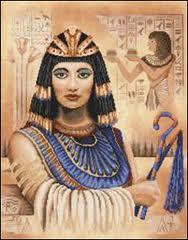
**Ramses II:
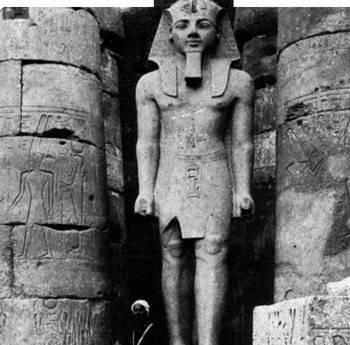
Ramses II became King of Egypt when he was about 30 years old in 1279 BC. He was king for 67 years until 1212 BC. He had a lot of wives, 111 sons and 51 daughters.
Ramses II was a great warrior. During his fourth year as pharaoh, Ramses II fought to regain the territory in Africa and western Asia that had been taken by the Hittites. He fought in a series of campaigns against the Hittites, a very strong enemy. The war ended when Ramses II made an agreement with the Prince of the Hittites to divide the land between the two groups. Egypt agreed not to trespass on the Hittites territory and the Hittites agreed not to trespass on Egyptian territory. Ramses II was also a great builder. He built many temples throughout his empire.
**King Tutankhamun:
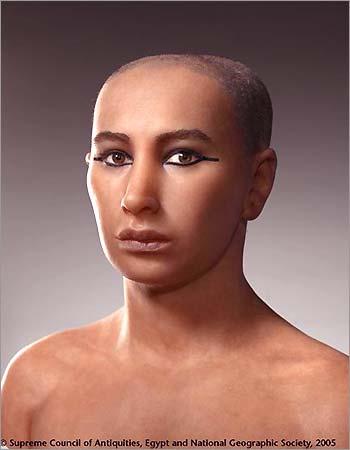
King Tutankhamun [toot-tan-kha-mon] became an Egyptian pharaoh in 1333 BC, when he was only nine years old. He ruled Egypt for nine years until he died at the age of 18 in 1325 BC.
It was believed that whoever entered Tut's tomb would immediately die because of a curse placed on his tomb. Several workers did die, but they died from bacteria sealed in the tomb, not the curse. The bacteria got on the workers' food and in the air they breathed, killing them.
The archeologists discovered many treasures in King Tut's tomb including thrones, beds, chariots, cloths, and statues of gods. Most of his treasures were made from gold, ivory, and precious stones. His coffin was the most magnificent. It was made from solid gold, and weighed 2,500 pounds. Today it is worth $13 million. The headpiece is a stunning example of ancient goldsmith's art. It was made of gold, ebony, and turquoise, and it was lined with many different stones and colored glass.
There were 4 rooms in his burial chamber. They held more than 5,000 objects, including finely carved chests, beds, chariots, linens, clothing, jewelry, statues of Tut and Egyptian gods, figures of animals, models of ships, and toys. A chest held his canopic jars, with his liver, intestines, lungs, and stomach inside them. The four canopic jars were essentially small copies of the king's second coffin. Tut's outer golden shrine was protected by four goddesses, Isis, Nephthys, Neit, and Selket.
Although he was not an important king, Tutankhamun is well known today because his tomb contained amazing treasures and was found almost untouched by a British archaeologist in 1922, almost 3,000 years after he had been buried. King Tutankhamun was buried in a tomb deep in the Valley of the Kings, a place where royal Egyptians were buried.
**Ramses III:
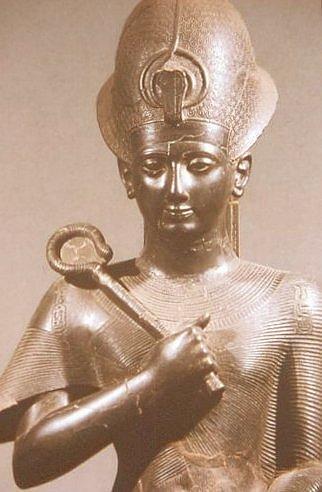
By the time of Ramses III (1182 - 1151 BC), the world was going through great change. During the first few years of his reign, Ramses III brought his country together.
Ramses III was a great military leader who repeatedly saved the country from invasion. In the fifth year of his reign, Egypt was well prepared for an attack by the Libyans from the west. With a well-organized and efficient army, Ramses III easily defeated the Libyans. The Libyan attack was nothing compared to the much greater threat that came three years later. The Sea Peoples were ready to make a move on Egypt. They were marching south along with a huge fleet of ships heading towards the eastern Nile delta. Ramses III established a line of defense in Southern Palestine and got every available ship to secure the entrance to the Nile. The Egyptian army defeated the Sea Peoples on land, but their navy continued towards the Nile delta. Their plan was to defeat the Egyptian navy and force an entry up the river. Although the Egyptians had a poor reputation as seamen, they fought long and hard. Ramses III lined the shores with part of his army which shot arrows at the enemy ships as they tried to land. Then the Egyptians attacked using grappling hooks to haul in the enemy ships. In the brutal hand to hand fight, the Sea Peoples were defeated.
Ramses III was also a builder of temples and palaces. His victories are depicted on the walls on his temple at Medinet Habu, near Luxor.
Ramses III had two wives and several minor wives. Tiye, one of his minor wives was the cause of his destruction. She wanted to kill Ramses because she wanted her son, Prince Pentaweret, on the throne. She and her army plotted to kill Ramses III using magic wax and poison. The plot failed but not until after Ramses III was mortally wounded. They were arrested and went to trial. Ramses III died before the trial was completed.
Ramses III was the last of the great rulers of Ancient Egypt. His death was followed by centuries of weakness and the Egyptian empire was ruled by foreigners.
*Hieroglyphs*
Hieroglyphics was the form of writing used in ancient Egypt. It is a form of picture writing, or, as the answer below says, "Egyptian writing through symbols". Each symbol is an hieroglyph. Each cluster of symbols represented a word or idea rather than simple sounds like the symbols in an alphabet. Some hieroglyphs were alphabetic sounds. Others were "determinatives". The latter helped the reader distinguish between different words that had the same basic set or cluster of symbols (hieroglyphs). Thus, there were many different symbols. The large number of symbols perhaps reflects the changing nature of the Egyptian language over many centuries. For example, imported words regularly entered the vocabulary because of commerce, migration, colonization or conquest.
"Hieroglyphic" is actually the adjective used for the type of writing. Hieroglyphic writing, in contrast to alphabetic writing, is a form of writing where pictures and drawings serve as representations of words.
It might be worth noting here that the Rosetta Stone helped to decode or decipher the Hieroglyphs using the Greek and Coptic words also found on that stele. On that stele, the scribes wrote the same message in three different languages. However, the hieroglyphs on the Rosetta Stele probably represented meanings current around the time of the Ptolemaic kings of Egypt (from 300 BC). The words in hieroglyphs may have simply been words in Coptic or 3rd Century BC Greek but written using the hieroglyphs, instead of Greek letters, as the alphabet or writing language. As such, the Rosetta Stone may therefore not tell us much at all about the ancient Egyptian language (or languages) of the early dynasties when a languag more akin to ancient Hebrew was spoken (e.g., in 2000 BC). Furthermore, there is a debate regarding the status of hieroglyphs and how much meanings changed over time. For example, hieroglyphs on a 12th dynasty monument may have represented words on a 19th or 26th dynasty monument that were quite different in meaning.

* Pyrimads *
 Khufu's pyramid is 450 feet high. It is both one of the Seven Wonders of the World and the largest stone building on Earth. This pyramid is built from more than 2.3 million limestone blocks, with each block weighing about 2.5 tons.
Khufu's pyramid is 450 feet high. It is both one of the Seven Wonders of the World and the largest stone building on Earth. This pyramid is built from more than 2.3 million limestone blocks, with each block weighing about 2.5 tons.
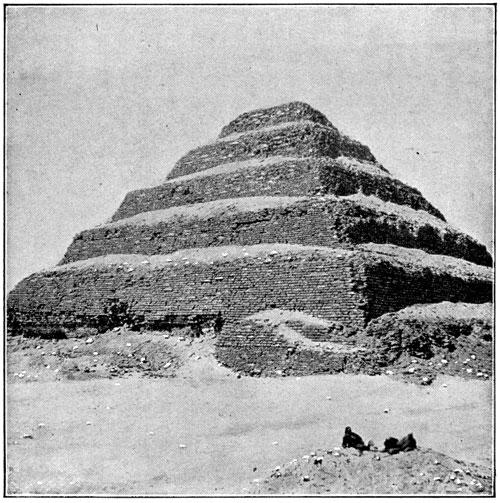 The first pyramids the Ancient Egyptians built were "step pyramids." Later in the history of Ancient Egypt, the Egyptians began constructing the smooth-sided pyramids that have become more known to the modern world than the earlier pyramids.
The first pyramids the Ancient Egyptians built were "step pyramids." Later in the history of Ancient Egypt, the Egyptians began constructing the smooth-sided pyramids that have become more known to the modern world than the earlier pyramids.
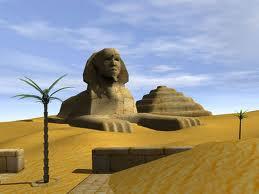
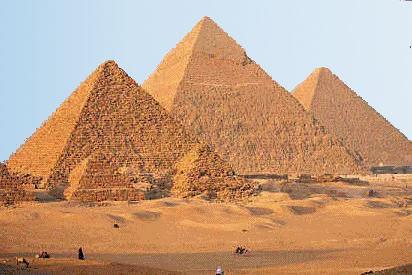
* Historical Epochs: Three epochs are known as the Old Kingdom, the Middle Kingdom and the New Kingdom.
3200-2300 BC - dynasty I-IV - Old Kingdom
2300-2050 BC - dynasty VII-XI - First intermmediate period
2052-1775 BC - dynasty XI-XII - Middle Kingdom
1775-1575 BC - dynasty XIII-XVII - Second intermmediate period
1575-1085 BC - dynasty XVIII-XX - New kingdom
1085-709 BC - dynasty XXI-XXIV - decline period
709-332 BC - dynasty XXV-XXX - late period
332-30 BC - ptolemaic period
30 BC - Egypt is conquered by the roman empire
641 AD - Egypt is conquered by the Arabs.
* Religion *
Without the ancient Egyptian Religion, there would probably be little reason for one to visit Egypt today. The great Pyramids would not exist, nor of course, would there be the fabulous temples, the tombs on the West Bank of Thebes (modern Luxor) and their mummies, or the colorful decorations that adorn these structures that have lured travelers to Egypt over the past three thousand or so years. Behind every aspect of Egyptian life, including the art, the political structure and the cultural achievements one must see the religious forces that shaped the fabric of ancient Egypt.
The spiritual world that was created by the ancient Egyptians was a richly fascinating one which remains unique in the history of human religion, but at the same time, somehow familiar in many ways. The character of that spiritual world was both mysterious and manifest, at once accessible and hidden, for although Egyptian religion was often shrouded in layers of myth and ritual, it nevertheless permeated the ancient civilization of the Nile and ultimately shaped, sustained and directed Egyptian culture in almost every way.
One thing that does seem familiar about their ancient religion was that people were very concerned about the afterlife. Furthermore, in order to avoid being counted among the damned of the afterlife, one had to not only venerate the Egyptian gods,, but also live by a code of standards that would be judged after death.
Herodotus tells us that the Egyptians "are religious to a higher degree than any other people" Some six centuries later, in the Perfect Discourse, Hermes Trismegistos summed up the spirit of Egyptian religious beliefs for his disciple, Asclepius, in a striking metaphor:
"[Egypt] has become the image of heaven, and what is more, the resting place of heaven and all the forces that are in it. If we should tell the truth; our land has become the temple of the world"
Like the members of any other human culture, the ancient Egyptians were driven to find meaning in existence, but there were also other influences on their religion, such as the need to justify kingship, among others.

1.)This is quite disgusting to imagine but in ancient Egypt when a body was mummified, its brain was removed through one of its nostrils and its intestines were also removed and placed in jars called canopic jars. The only internal organ that was not removed was the heart, because Egyptians considered it to be the seat of the soul. Thank God we don’t practice mummification after death anymore.
2.)Pepi II of Egypt was known for many things but did you know that in order to deter flies from landing on him the Pharaoh always kept several naked slaves nearby whose bodies were smeared with honey.

3.)“Death will slay with his wings whosoever disturbs the peace of Pharaoh.” This was an inscription found on a clay tablet in Tut’s tomb. Twenty people associated with the discovery died shortly after the tomb opening. It is believed that they were cursed.
4.)Cats were very sacred to the Egyptians. In the event of a fire, cats would be rescued from the building before any humans. This is something that will make our animal activists happy for sure.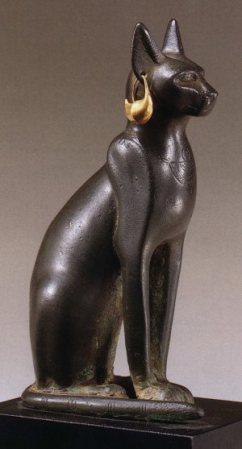
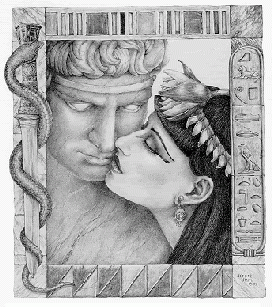
5.)Did you know about the Romeo and Juliet Twist towards the end of the Egyptian dynasty?
Mark Antony stabbed him self with his sword on the battlefield outside Alexandria while trying to fend of his former country men. He was brought to the tomb where Cleopatra had locked her self in, and died in her arms…After the war was over and Egypt was defeated Cleopatra, the last ruler of Egypt who was imprisoned in her own palace tricked Octavian into visiting Antony’s Tomb. She had someone bring her some poisonous snakes and incited them to bite her. Caesar ordered that the two lovers be buried together.


